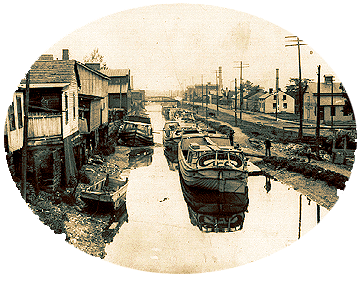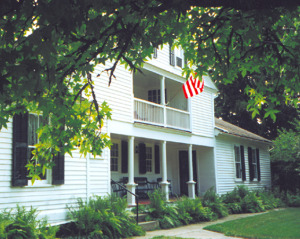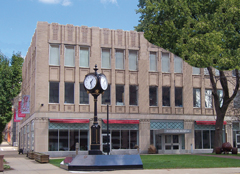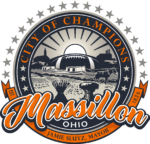
Ohio & Erie Canal in Downtown Massillon
Looking south from the Tremont Avenue
bridge about the turn of the century.
Courtesy Massillon Museum
Meet Massillon, Ohio!
Massillon is located in Northeast Ohio, in Stark County on the banks of the Tuscarawas River, which the Ft. McIntosh Treaty of 1785 delineated as the boundary between Native American land and the territory of the United States.
The fertile rolling hills, temperate climate, and water power originally attracted intrepid New Englanders, who introduced Merino sheep and woolen mills along the bubbling Sippo Creek, a tributary of the Tuscarawas River. Soon after Thomas Rotch founded Kendal in 1812, fellow Quakers and seafarers joined him from the Massachusetts and Connecticut coast. Rotch and his wife, Charity, exemplified their Quaker faith by using their farmhouse as one of several local stations on the Underground Railroad. After the passing of the Rotches in the 1820s, Kendal temporarily reinvented itself as a Utopian experiment, which lasted just three years. The Rotches’ Spring Hill farm is now on the National Register of Historic Places and a site on The National Road to Freedom.

When the War of 1812 halted shipping, a seaman, James Duncan, turned his adventurous spirit toward “the West.” While visiting Kendal, he decided to purchase land along the Tuscarawas River—two miles further southeast—to develop his own town. Duncan recorded Massillon in 1826, immediately lobbying the State of Ohio to route the proposed Ohio and Erie Canal through his land rather than the land on the west side of the river, where William Henry would soon found West Massillon.
When the Port of Massillon opened in 1828, the Wellman brothers built a warehouse beside the canal. Their offer of cash for wheat drew farmers from miles around, earning Massillon the sobriquet, “The Wheat City.” Canal boats also hauled local coal to fuel freighters on Lake Erie. Canal prosperity continued until the railroad arrived in 1852. The canal sliced through the town, diminished in its usefulness, until the banks washed away in the Flood of 1913.

When the first train whistled into Massillon from Pittsburgh, the ten-year-old Russell & Co. was manufacturing steam engines that needed a faster, stronger shipping option to reach markets across the continent. The company led Massillon’s industrial production into the first decade of the twentieth century. During that era, numerous glass factories took advantage of the local abundance of silica sand and coal to produce thousands of beer bottles during the cooler months each year. The Hess-Snyder Company manufactured stoves, furnaces, pumps, and windmills. Massillon’s Joseph Davenport, inventor of the cowcatcher and cantilever bridge, founded Massillon Bridge Company.
When the town incorporated in 1853, the villages of Kendal and West Massillon—which had been founded in 1831 by William Henry on the west bank of the river—merged with the bustling downtown area to become the unified Massillon. Two smaller villages further west on Massillon’s main street, the old state road (later The Lincoln Highway), were incorporated into the town during its centennial year, 1926.
The second half of the 1800s was, in contrast to the city’s large population of mill workers, also the heyday of wealth and influence in the community. Bankers and owners of the big factories built mansions on Prospect Street overlooking the burgeoning town. Bank director Caroline McCullough Everhard led the successful movement to gain Ohio women the right to vote in municipal elections. An opera house and impressive church spires punctuated the skyline, all built of locally quarried sandstone.
During the 1890s, the leisure-time energy of Massillon’s many factory workers turned to football. High school Tiger players often doubled as professional gridders as they initiated the football passion that consumes the community more than a century later. The town, which has raised more than two dozen professional football players and ten professional baseball stars, carried the nickname “The City of Champions,” during the second half of the twentieth century. That moniker has been revived and Massillon is known again today as “The City of Champions.”
The same year that the nationally famous Massillon and Canton McKinley football rivalry started, Jacob Sechler Coxey conceived the concept of a protest march and led his famous “army” of unemployed men on foot from Massillon to the nation’s capital to promote economic bills he had suggested to Congress. Coxey later ran for President, following the footsteps of Victoria Claflin Woodhull, who had made a bid for the Presidency in 1872, after she left Massillon.
The State of Ohio built a mental hospital with picturesque castle-like edifices on the hills at the south edge of town in the late 1890s. Housing as many as 3,000 patients, it employed hundreds of local people into the mid-1900s. Patients tended gardens so lovely that tourists visited from other states; they raised enough produce on the farm to feed residents of all Ohio institutions.
In 1915, the Central Steel Company (later merged into the Republic Steel Corporation) lit its first blast furnace, the beginning of the steel industry that buoyed the town through the middle of the twentieth century. Concurrently, the Griscom-Russell Company emerged from the former Russell & Co. to produce heat exchangers that became essential for industrial and military applications.
Flooding crippled the business district every spring. In 1939, civic leaders set a mammoth flood control and railroad safety project in motion. After inactivity during World War II, the community celebrated completion in 1951. Three viaducts spanned the widened and straightened river, newly lined with levees. Railroad tracks—previously dangerous grade crossings—were consolidated, also beneath the viaducts.
Some of the same visionaries who solved the flooding issue foresaw the downfall of the steel industry. Forming what is known today as the Massillon Development Foundation, they organized investors to create industrial parks and recruited new industries before the town became a typical Rust Belt shell. Within the new diversified economic base are companies that process food; manufacture products as divergent as truck caps, pulleys, polymer packaging, paper products, advertising displays, and plastic containers; drill wells; and repair huge heat exchangers and electrical motors.

Today, downtown storefronts sport colorful awnings as they compete with outlying commercial centers. The City’s Summer Concert Series on the newly renovated Duncan Plaza fill the summer air with music every Thursday evening from late June to the middle of August. The downtown is filled during summer months with other activities including the Cruise-On-In and Dance Party, Family Fun Fest, and the Massillon Museum Island Party to name a few. Stay tuned because new events are coming for 2022! Fans and traditionalists flock to the football stadium in the fall.
The canal towpath, revived as a hiking and biking trail from Cleveland through Massillon, augments the town’s thirty parks and green spaces. The Lincoln Theatre serves as a center for cinema and live performances. The Massillon Museum, the community’s cultural hub, is at the heart of downtown activities, offering ever-changing exhibitions, a popular coffee shop, research opportunities, classes, and a creative and constant parade of free public events.
Today, Massillon is a community of 32,146 (2020 Census Update) encompassing approximately 19.388 square miles and 176.59 miles of streets. Massillon includes more than 14,497 dwelling units, with a high percentage of residents owning their own homes.
